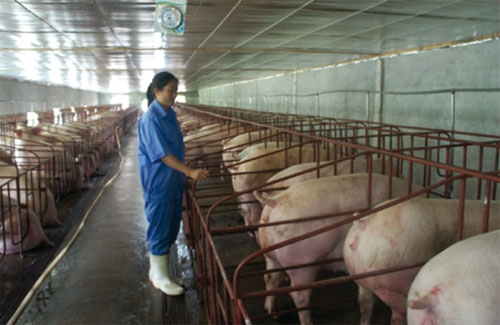
Since early this year, the price of pork has decreased significantly, seriously affecting farmers. The Ministry of Agriculture and Rural Development has come up with immediate and long-term solutions, emphasizing production chain development.
 |
Since early this year, the price of pork has decreased significantly, seriously affecting farmers. The Ministry of Agriculture and Rural Development has come up with immediate and long-term solutions, emphasizing production chain development.
Supply exceeding demand
Minister of Agriculture and Rural Development Nguyen Xuan Cuong said at an April 24 meeting with animal husbandry businesses that supply has exceeded demand on the domestic animal husbandry and aquaculture product market, and pork products in particular are facing huge market disadvantages.
Pork production is expected to reach 3.7 million tonnes in 2017, three percent more than 2016, 200,000and 200,000 tonnes higher than the domestic market’s project demand. Including pork imports, the supply would far exceed demand.
Supply exceeding demand has caused pork prices in the domestic market to drop considerably. The price of pigs with live weight of 100-110kg/ head has dropped to less than VND25,000-28,000 per kilo and is expected to drop further. Farmers are suffering an average loss of VND1.5 million per pig.
But while farmers are having to sell their pigs at lower prices, consumer prices for pork products are unchanged. Nguyen Xuan Duong, deputy director of the Department of Livestock Production, said although the state’s related policies are relatively clear and adequate, he still attributes the problem to the poor management and unprofessional production, slaughtering, processing and sales of husbandry products.
The Ministry of Agriculture and Rural Development has asked localities and enterprises to strengthen cost control to decrease product costs and prices. Five enterprises have committed to a reduction of VND200/kg of pig feed of all kinds (roughly almost VND100 billion per month) for farmers. Meanwhile, slaughterhouses and processing and freezing facilities have maximized their capacity so they can buy more pigs from farmers. These, in addition to programs for connecting businesses with farmers, have increased the price of pigs (according to live weight) by VND5,000-7,000 per kilo and reduced the price of pork paid by consumers by 10-30 percent.
Traditional husbandry invalid
No matter whether they run a small or big pig farming facility, most pig farmers in Vietnam are still applying the traditional husbandry model under which they produce piglets themselves, farm the animals and sell the matured ones to merchants. This model is no longer suitable to the modern market’s demand for products strictly controlled and managed in terms of food safety and hygiene and product origin.
Dong Nai Province has become the biggest pig farming center in Vietnam. The Dong Nai Province Department of Agriculture and Rural Development said the province has built 23 cooperatives in accordance with Vietnamese Good Agricultural Practices (VietGAP), attracting 400 farmer households. Despite the pig price crisis, these cooperatives are still maintaining their stable sales and product prices that are higher than those of pigs from traditional farming facilities. Many businesses said they are willing to purchase pigs from such cooperatives because of their good quality. However, the 400 households just account for a small part of the 14,000 pig farming facilities in Dong Nai. The situation is similar in many localities.
On April 27, Minister of Agriculture and Rural Development, Nguyen Xuan Cuong, issued Document 3511/BNN-CN on urgent solutions for stable and developed animal husbandry, including pig farming. The document calls on people’s committees of centrally governed provinces and cities to oversee immediate implementation of livestock breeding development solutions. These include provision of guidelines for farmers to apply advanced husbandry techniques to minimize production costs, strengthening market and price management, and creating good conditions for farmers to sell their products.
Importance of production chains
The ministry told provincial and other relevant authorities to restructure animal husbandry activities towards forming consistent production chains and maximizing the role of enterprises, associations and cooperatives in assuring products meet safety and hygiene standards and balancing market supply and demand. The ministry also told them to implement overall market development solutions for livestock products of specific localities, and take the initiative in local and inter-regional connectivity development. In addition, the ministry asked localities to review and issue animal husbandry statistics in order to prepare appropriate master plans for livestock breeding development, which promote market stability and ensures environmental protection and food safety and hygiene.
Experts say consumers should buy domestically produced pork to support domestic pig farmers and pork producers.
(Source:VEN)





